Food poverty: global, regional and national
This factsheet explains what food poverty is and how it’s measured, as well as unpacking the latest trends at the global, regional and national levels.
DownloadsRead our latest factsheet
You are reading our 2020 factsheet about food poverty. Click the button below to read our latest, 2023 factsheet.
Food poverty: Key findings and trends 2000−2023This factsheet provides an overview of food poverty trends at the global, regional and national levels. It unpacks the terminology used to describe food poverty, explains how it’s measured and compares international food poverty lines.
Key facts
Global trends in food poverty
- The global share of people in food poverty has decreased overall since 1990, and year-on-year since the start of 1999 − falling from 22% to 6% in 2015. However, over 460 million people are still unable to afford enough food to live a healthy life.
- The rate of people moving out of food poverty has remained consistent throughout the Millennium Development Goals (MDG) period (2000−2015) − around 5.5% annually − whereas the rate of reduction in extreme poverty accelerated − from 4% to over 7.5% annually. [1]
Regional trends in food poverty
- Since 1990, the number of people living in food poverty has increased by almost 20% in Middle East and North Africa, and over 25% in sub-Saharan Africa. These regions now represent 62% of all people in food poverty. [2]
- Of all regions, East Asia and Pacific has seen the largest decreases in both the number and global share of people living in food poverty since 1990, with more than 685 million people moving out of food poverty by 2015.
Food poverty at a national level
- Three economies − Democratic Republic of Congo (DRC), India and Nigeria − are together home to more than 100 million people living in food poverty.
- Just six economies – Angola, Burundi, Central African Republic (CAR), DRC, Madagascar and Togo – have more than half of their population living in food poverty. All are situated in sub-Saharan Africa.
Introduction
What does it mean to live in food poverty?
Food poverty is lacking the means to obtain enough food to live a healthy life. People living in food poverty have an income or expenditure that is less than the amount needed to consistently afford a basket of food with minimum recommended nutritional intake. The cost of this basket is called a food poverty line (FPL) − people living below the FPL are not able to afford the cost of food necessary for good health and are in danger of malnutrition, disease or ill health.
The monetary value of a FPL is most often based on the cost of affording a minimum energy intake using locally available goods − this is known as the food energy intake (FEI) method. A global standard for the threshold of food poverty is 2,100kcal per adult per day , which is the Food and Agriculture Organization’s (FAO) recommended daily energy intake to enable an adult to live a healthy and moderately active life. [3]
As the cost of non-food essentials are not included, the FPL is often considered the most extreme measurement of monetary deprivation. Higher poverty measures, such as national poverty lines, consider the cost of a combination of both food and non-food essentials (for example, housing, clothing, education and access to water, sanitation and electricity). People living in food poverty are forced to prioritise between food and non-food essentials on a daily basis.
How is food poverty measured?
Food poverty is measured using data from national household surveys which capture household income and/or expenditure data. [4] If a household’s average per person income or expenditure is less than the FPL, all individuals in the household are considered to be in food poverty. [5]
FPLs themselves are created from household surveys which measure food consumption patterns and the prices of local foodstuffs. FPLs are then set by national statistical offices, such that they reflect the local cost of food. FPLs may be created for subnational regions, reflecting different prices or consumption patterns of food. Many economies use differing thresholds of food poverty in urban and rural areas.
Tracking the number of people living in food poverty globally is not straightforward. Unlike extreme poverty − which has a universally fixed poverty line of $1.90 per adult per day [6] − the threshold of food poverty varies depending on the local cost of food and consumption behaviours. Based on national sources, Development Initiatives (DI) has calculated the rate of food poverty across 121 economies, with data available for over three quarters of the world population.
Global trends in food poverty
Established in 2000, the MDGs placed ‘eradicate extreme poverty and hunger’ as a key aim, with 1990 set as the benchmark year for measuring progress against. In 2015, the Sustainable Development Goals (SDGs) enshrined the target of ‘ending poverty in all its forms everywhere’ as its first goal. Ending food poverty is an intrinsic requirement of the SDGs. Food poverty is the most extreme form of destitution − people living in food poverty cannot afford necessary food to live a healthy life and are forced to forgo food to afford non-food essentials. By ending poverty in all its forms, no one should remain living in food poverty by 2030.
The global share of people living in food poverty has been decreasing year-on-year since the start of the MDG era
Based on economies with available data, in 1990 over one quarter (27%) of the world’s population lived in food poverty; in 1999, the last year before the start of the MDGs, this had fallen to just over a fifth (22%). Throughout the MDG era, the share of people living in food poverty has consistently fallen year-on-year − in 2015, the latest year for which data is available, an estimated 6.3% of the world’s population lived in food poverty − approximately 460 million people. [7] For comparison, it is estimated that 10% of the global population, 732 million people, lived in extreme poverty.
Figure 1: The number of people living in food poverty has dropped by two thirds since 1999, but over 460 million people still live below the food poverty threshold
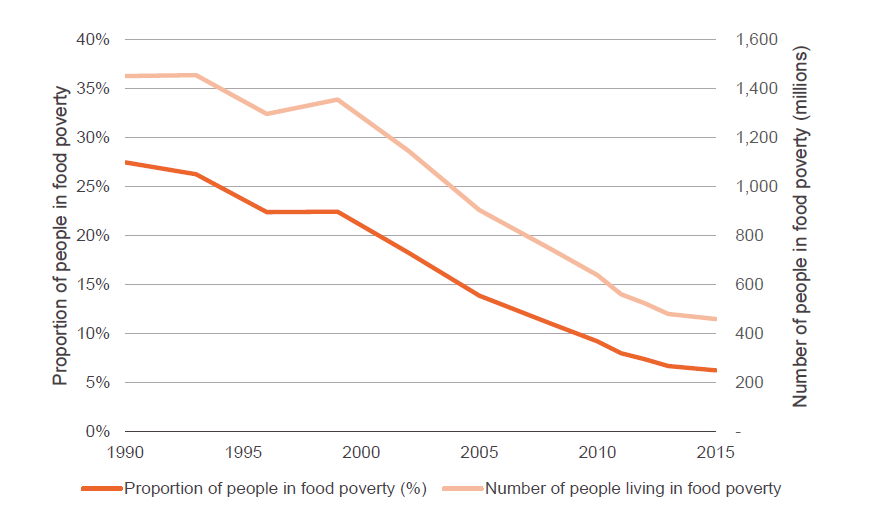
Figure 1: The number of people living in food poverty has dropped by two thirds since 1999, but over 460 million people still live below the food poverty threshold
Source: Development Initiatives based on national sources, World Bank, Food and Agriculture Organization and PovcalNet.
The rate of food poverty reduction remained consistent throughout the MDG period, whereas reductions in extreme poverty accelerated
The rate of reduction of food poverty, as measured by the percentage of people moving out of food poverty year-on-year, demonstrates that food poverty has consistently reduced over the entire MDG period. Over 5-year increments, the number of people living in food poverty has consistently reduced by 5−6% annually. This is in contrast to rates of reduction in extreme poverty which have accelerated from 4% in 2000−2005 to over 7.5% annually in 2010−2015.
Figure 2: The number of people living in food poverty has reduced consistently annually since 2000, but reductions in extreme poverty have increased over this period
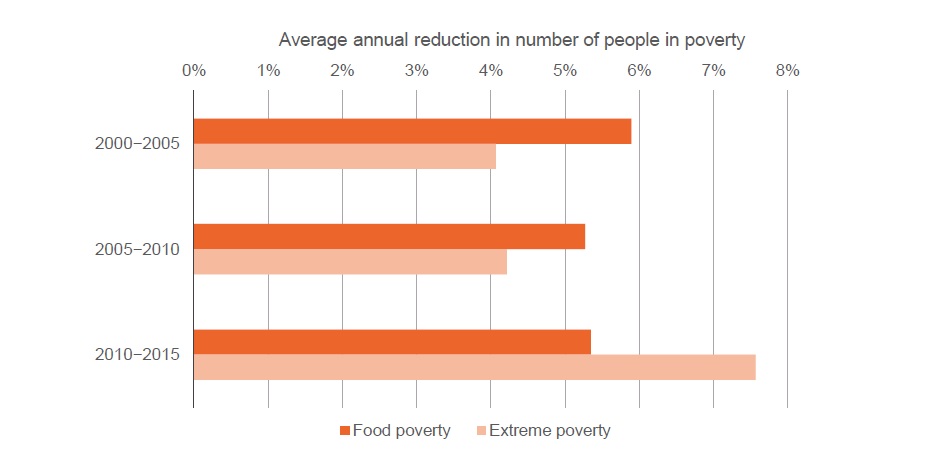
Figure 2: The number of people living in food poverty has reduced consistently annually since 2000, but reductions in extreme poverty have increased over this period
Source: Development Initiatives based on national sources, World Bank, Food and Agriculture Organization and PovcalNet.
Regional trends in food poverty
At a global level, food poverty has declined consistently since the start of the MDG era. However, this trend is not the same across every region. Tracking the changes in poverty rates at a regional level reveals the changing geographical makeup of people living in food poverty and illuminates where future efforts to eliminate food poverty should be more greatly focused.
Since 1990, the number of people in food poverty has increased in Middle East and North Africa and sub-Saharan Africa
Between 1990 and 2015, all regions saw a decrease in the proportion of people living in food poverty. However, in Middle East and North Africa and sub-Saharan Africa, the number of people living in food poverty increased by 5.5 and 53 million respectively to a combined total of over 280 million people in 2015. Whereas in 1990 these regions represented just 16% of the global share of food poverty, in 2015 they made up over 60%.
Figure 3: The number of people living in food poverty in the regions of sub-Saharan Africa and Middle East and North Africa has increased from 225 million in 1990 to 284 million in 2015

Figure 3: The number of people living in food poverty in the regions of sub-Saharan Africa and Middle East and North Africa has increased from 225 million in 1990 to 284 million in 2015
Source: Development Initiatives based on national sources, World Bank, Food and Agriculture Organization and PovcalNet.
East Asia and Pacific has seen the largest decreases in both the number and share of people living in food poverty
Even prior to the start of the MDGs, the strongest reductions in food poverty occurred in East Asia and Pacific. In 1990, 40% of people in the region were living below the food poverty threshold − equivalent to over half of all people living in food poverty at the time (725 million). By 1999, more than 250 million people had moved out of food poverty, and as of 2015 a further 426 million moved above the food poverty threshold. As of 2015, less than 5% of people in the region were considered to be in food poverty − a global share of less than 10%.
Figure 4: The global share of people living in food poverty in East Asia and Pacific has decreased from 50% in 1990 to less than 10% in 2015
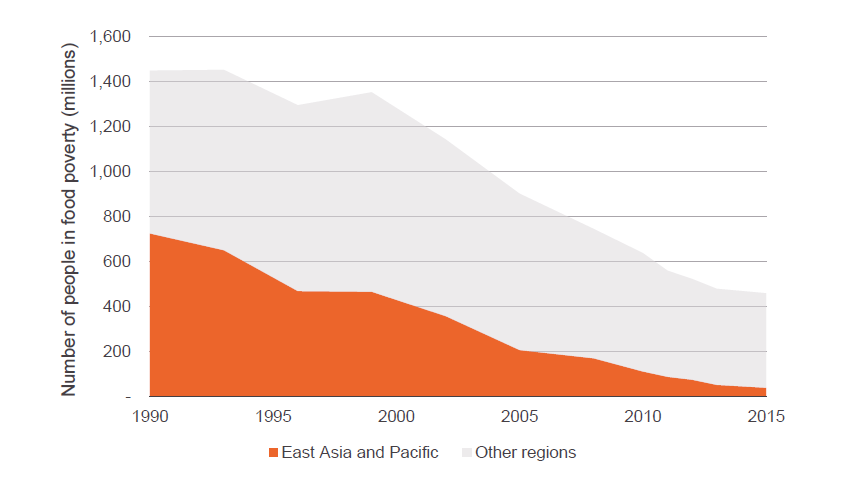
Figure 4: The global share of people living in food poverty in East Asia and Pacific has decreased from 50% in 1990 to less than 10% in 2015
Source: Development Initiatives based on national sources, World Bank, Food and Agriculture Organization and PovcalNet.
Food poverty at a national level
Over the MDG period, food poverty became increasingly concentrated in the region of sub-Saharan Africa, but wider regional trends hide differences in national burdens of food poverty both within and outside of sub-Saharan Africa. The SDGs’ primary aim of “ending poverty in all its forms everywhere ” requires that food poverty be assessed and tracked at least at national level.
Figure 5: India, Nigeria and the Democratic Republic of Congo were home to the largest food poor populations in 2015, but the Central African Republic and Burundi had the largest shares of national populations living in food poverty
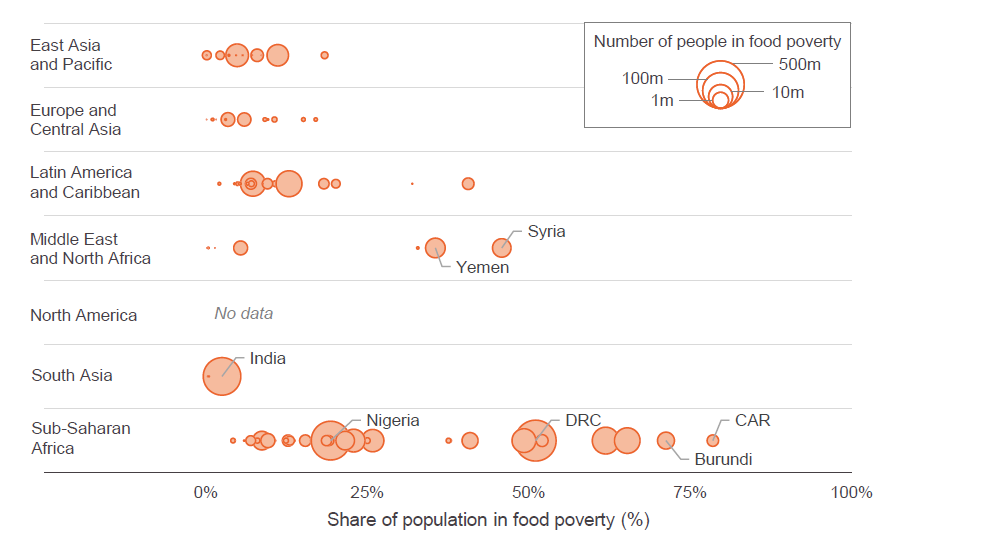
Figure 5: India, Nigeria and the Democratic Republic of Congo were home to the largest food poor populations in 2015, but the Central African Republic and Burundi had the largest shares of national populations living in food poverty
Source: Development Initiatives based on national sources, World Bank, Food and Agriculture Organization and PovcalNet.
Notes: CAR: Central African Republic; DRC: Democratic Republic of Congo
Democratic Republic of Congo, India and Nigeria are home to more than 100 million people in food poverty
At the start of the SDG era, almost a quarter of all people living in food poverty were situated in just three economies − DRC, India and Nigeria. Each of these economies is separately home to more than 30 million people in food poverty, in no small part due to their large overall populations. However, while just over half of DRC’s population lived in food poverty, the proportion of Nigeria’s population who were food poor was 19%, and India’s was less than 5%.
Six economies have more than half of their population in food poverty − all in sub-Saharan Africa
As of 2015, the most food impoverished economies in the world were Burundi and CAR, which both had more than 70% of their population living in food poverty. More than half of the populations of four more economies – Angola, DRC, Madagascar and Togo − all lived below the FPL. These six economies together represented 87 million people living in food poverty − close to one fifth of the global total.
Appendix
Methodology
DI examined national source documents to establish the threshold of food poverty on an economy-by-economy basis. Food poverty lines (FPLs) were identified as national or subnational thresholds representing a minimum cost of living based solely on the energy intake of local foodstuffs. Where possible, FPLs produced using a nationally relevant food energy intake (FEI) methodology were taken. FPLs which were presented with a different or missing methodology were taken where no FEI alternative was available. [8] In several cases, national sources would present data on ‘national poverty lines’ (NPL), of which a food-only component was a constituent element. In these cases, this component was considered as the FPL.
In total, 132 economies were found to have data on nationally defined poverty lines, of which 123 contained references to a FPL or food-only poverty component. 95 economies also recorded the equivalent calorific threshold for the FPL − this ranged from 1,460kcal to 3,000kcal. Where no calorie value was given, it was assumed the FPL represented the internationally standard 2,100kcal per adult equivalent per day. In cases where economies had published subnational FPLs only, the food-poor population-weighted average of the subnational lines were taken to produce a representative national average.
As established by the World Bank’s PovcalNet, China, India and Indonesia each have separately recorded urban and rural poverty measures. The same split approach was taken in producing FPLs for these economies (as China does not have an urban FPL, the ratio of the rural to urban NPL was used to estimate an urban FPL). This ensures that spatial price differences in the largest population economies are recognised.
In all cases, the most recently available FPL was taken. While this reduces the relevance of FPL reference baskets in historical observations, the lack of frequently updated FPLs for most economies coupled with inconsistent methodologies in those that do update their FPLs meant that this was the most reasonable choice. The most recent year of FPL data across all economies ranged from 1999 to 2018, although only two observations were from before 2000. The median, mode and mean year of FPL observation was 2011. For this reason, and for ease of comparability with the most recent round of the International Comparison Program’s (ICP) purchasing power parity (PPP) prices, each FPL was deflated to 2011 prices. [9]
FPL deflation to 2011 prices used the following method in order of priority based on data availability: national source food poverty price indices; Food and Agriculture Organization food consumer price indices; PovcalNet consumer price indices; World Bank Data Bank consumer price indices. Finally, the FPLs were normalised to the recommended international threshold of 2,100kcal per adult per day.
International comparisons of food poverty lines
Food poverty is different to extreme poverty − the latter is defined by a fixed international threshold of PPP$1.90 per adult per day, based on the median national poverty line of 15 low income economies. [10] The expression of the extreme poverty line in PPP dollars is designed to make the ‘reality’ of this monetary threshold the same – equivalent to the purchasing power of US$1.90 within the United States – regardless of the economy it is measured in.
As FPLs are based solely on the local cost of food required to meet a common energy intake (i.e. a common ‘reality’), PPP conversions therefore should express a very similar US dollar equivalent for FPLs in each economy. However, this is not the case − when local FPLs are expressed in PPP dollars, there is no alignment to a common international value. This finding is problematic for the concept of extreme poverty, as it indicates that PPP conversions are not suitable in making the cost of basic needs comparable between economies.
DIs’ research indicates that upper middle-income economies tend to have food poverty thresholds above the value of the extreme poverty line, whereas low-income economies have FPLs less than PPP$1.90; there is significant variation within all income groups (Figure A1). These findings indicate that the extreme poverty line does not adequately measure deprivation of energy intake in many economies.
Figure A1: National food poverty lines do not align when using international PPP dollars
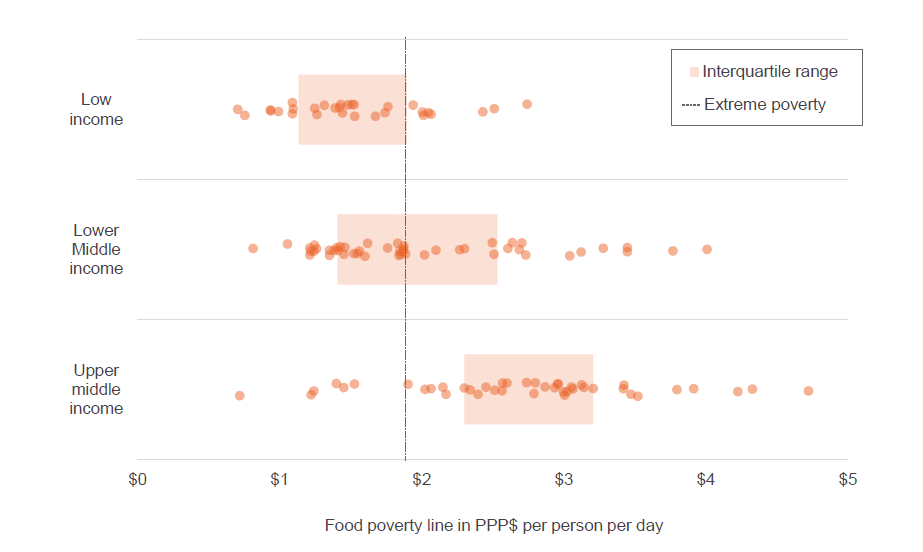
Figure A1: National food poverty lines do not align when using international PPP dollars
Source: Development Initiatives based on national sources, World Bank, Food and Agriculture Organization and PovcalNet.
Notes: Data presented is for 121 economies. The two observations for high income economies have been excluded.
Table A1: Food poverty line sources
| Economy | Data year | Source institution | Economy | Data year | Source institution |
|---|---|---|---|---|---|
| Afghanistan | 2016/2017 | Islamic Republic of Afghanistan Central Statistics Organization | Lebanon | 2011 |
Central Administration of
Statistics of Lebanon |
| Albania | 2002 | Albania Institute of Statistics | Lesotho | 2010/2011 | Lesotho Bureau of Statistics |
| Algeria | 1995 |
Algérie Office National des
Statistiques |
Liberia | 2007 |
Liberia Institute of Statistics and
Geo-Information Services |
| Angola | 2000/2001 |
Angola Instituto de Pesquisa Económica
e Social |
Libya | 2010 |
General People's Committee for
Planning and Finance Libya |
| Argentina | 2002 |
Argentina Instituo Nacional de
Estatisticas y Censos |
Macedonia, FYR | 2006 |
State Statistical Office of the
Republic of Macedonia |
| Armenia | 2009 |
Statistical Committee of the Republic
of Armenia |
Madagascar | 2010 |
Institut National de la Statistique de
Madagascar |
| Azerbaijan | 2001 |
State Statistical Committee of
Azerbaijan |
Malawi | 2011 | Malawi National Statistical Office |
| Bangladesh | 2010 | Bangladesh Bureau of Statistics | Malaysia | 2010 |
Economic Planning Unit and Department
of Statistics Malaysia |
| Belarus | 2001 |
Belarus Ministry of Statistics and
Analysis |
Mali | 2010 | World Bank |
| Belize | 2009 |
Belize Ministry of Economic
Development and Petroleum |
Mauritania | 2008 |
Mauritania Office National de la
Statistique |
| Benin | 2015 |
Bénin Institut National de la
Statistique et de l’Analyse Economique |
Mexico | 2017 |
México Consejo Nacional de Evaluacíon
de la Política de Desarrollo Social |
| Bhutan | 2017 | Bhutan National Statistics Bureau | Micronesia, Fed. Sts. | 2013/2014 |
Federated States of Micronesia
Statistics Division |
| Bolivia | 2017 |
Bolivia Instituto Nacional de
Estadística |
Moldova | 2011 |
Ministry of Economy of the Republic of
Moldova |
| Botswana | 2009/2010 | Botswana Central Statistics Office | Mongolia | 2013 | Mongolia National Statistics Office |
| Brazil | 2009 | FGV Social Centro de Politicas Sociais | Montenegro | 2018 | Statistical Office of Montenegro |
| Burkina Faso | 2009/2010 |
Burkina Faso Institut National de la
Statistique et de la Demographie |
Morocco | 2000/2001 | Maroc Haut-Commissariat au Plan |
| Burundi | 2014 |
Institut de Statistiques et d'etudes
Economiques du Burundi |
Mozambique | 2014/2015 |
Mozambique National Institute of
Statistics |
| Cabo Verde | 2015 |
Instituto Nacional de Estatística Cabo
Verde |
Myanmar | 2015 |
Myanmar Ministry of Planning and
Finance |
| Cambodia | 2009 |
Cambodia National Institute of
Statistics |
Namibia | 2003/2004 | Namibia Ministry of Finance |
|
Central
African Republic |
2008 |
Institut Centrafricain des
Statistiques et des Etudes Economiques et sociales |
Nauru | 2012/2013 | Nauru National Statistics Office |
| Chad | 2011 |
Tchad Institut
National de la Statistique, des Études Économiques et Démographiques |
Nepal | 2003/2004 | Nepal Central Bureau of Statistics |
| Chile | 2012 |
Ministerio de Desarrollo Social del
Gobierno de Chile |
Nicaragua | 2016 |
Nicaragua Instituto Nacional de
información de Desarrollo |
| China--Rural | 2014 | National Bureau of Statistics of China | Niger | 2011 |
Niger Institut National de la
Statistique |
| Colombia | 2016 |
Colombia Departamento Administrativo
Nacional de Estadística |
Nigeria | 2009/2010 | Nigeria National Bureau of Statistics |
| Comoros | 2004 | Comoros Direction de la Statistique | Papua New Guinea | 2009/2010 | National source |
|
Congo, Dem.
Rep. |
2012 |
Republique Democratique du Congo
Institut National de la Statistique |
Paraguay | 2018 |
Paraguay Dirección General de
Estadística, Encuestas y Censos |
| Congo, Rep. | 2011 |
Congo Centre Nationale de la
Statistique et des Etudes Economiques |
Peru | 2016 | Perú Instituto Nacional de Estadística e Informática |
| Costa Rica | 2009 |
Costa Rica Instituto Nacional de
Estadistica y Censos |
Philippines | 2018 | Philippine Statistics Authority |
| Cote d'Ivoire | 2015 |
Cote d'Ivoire Institut National de la
Statistique |
Romania | 2002/2003 |
Romania National Institute of
Statistics |
| Djibouti | 2017 |
Djibouti Direction de la Statistique
et des Etudes Démographiques |
Russian Federation | 2018 | Goskomstat |
|
Dominican
Republic |
2011 |
República Dominicana Oficina Nacional
de Estadística |
Rwanda | 2014 |
National Institute of Statistics of
Rwanda |
| Ecuador | 2006 |
Ecuador Instituto Nacional de
Estadistica y Censos |
Samoa | 2013/2014 | Samoa Bureau of Statistics |
| Economy | Data year | Source institution | Economy | Data year | Source institution |
|
Egypt, Arab
Rep. |
2015 |
Egypt Central Agency For Public
Mobilization & Statistics |
Sao Tome and Principe | 2010 |
Sao Tome and Principe National
Institute of Statistics |
| El Salvador | 2017 | El Salvador Dirección General de Estadística y Censos | Senegal | 2011 |
Senegal Agence Nationale de la Statistique et de la
Démographie |
|
Equatorial
Guinea |
2006 |
Guinee Equatoriale Direction générale
de la statistique et de la comptabilité nationale |
Serbia | 2006 | Serbia Bureau of Statistics |
| Eritrea | 1993 |
National Statistics Office of the
Government of Eritrea |
Sierra Leone | 2003 | Statistics Sierra Leone |
| Eswatini | 2009/2010 | Swaziland Central Statistical Office | Solomon Islands | 2012/2013 |
Solomon Islands National Statistics
Office |
| Ethiopia | 2015/2016 | Ethiopia Central Statistical Agency | Somalia | 2016 | World Bank |
| Fiji | 2008/2009 | Fiji Bureau of Statistics | South Africa | 2011 | Statistics South Africa |
| Gabon | 2017 |
Direction de la Statistique et des
Études Économiques du Gabon |
South Sudan | 2009 |
South Sudan National Bureau of
Statistics |
| Gambia, The | 2015/2016 | The Gambia Bureau of Statistics | Sri Lanka | 2002 |
Sri Lanka Department of Census and
Statistics |
| Georgia | 2015 | Geostat | St. Lucia | 2016 |
The Central Statistical Office of
Saint Lucia |
| Ghana | 2012/2013 | Ghana Statistical Service | Sudan | 2009 | Sudan Central Statistics Organisation |
| Guatemala | 2006 |
Guatemala Instituto Nacional de
Estadística |
Syrian Arab Republic | 2006/2007 |
Syrian Arab Republic Central Bureau of
Statistics |
| Guinea | 2012 |
Republique de Guinee Institut National
de la Statistique |
Tajikistan | 2009 | Tajikistan Agency on Statistics |
| Guyana | 2005 | Guyana Bureau of Statistics | Tanzania | 2010/2011 | Tanzania National Bureau of Statistics |
| Haiti | 2012 | Institut Haïtien de Statistiques | Thailand | 2002 |
Thailand National Economic and Social
Development Board |
| Honduras | 2018 |
Instituto Nacional de Estadísticas
Honduras |
Timor-Leste | 2007 |
Timor-Leste Directorate of National
Statistics |
| India--Rural | 2011/2012 |
India Ministry of Statistics and
Programme Implementation |
Togo | 2015 |
Togo Institut National de la
Statistique et des Etudes Economiques et Démographiques |
| India--Urban | 2011/2012 |
India Ministry of Statistics and
Programme Implementation |
Tunisia | 2015 | Statistiques Tunisie |
| Indonesia--Rural | 2017 | Indonesia Badan Pusat Statistik | Turkey | 2010 | Turkish Statistical Institute |
| Indonesia--Urban | 2017 | Indonesia Badan Pusat Statistik | Tuvalu | 2010 |
Tuvalu Central Statistics Department
of the Ministry of Finance and Economic Planning |
| Iraq | 2012 | National source | Uganda | 2013 | Uganda Bureau of Statistics |
| Jamaica | 2014 | Planning Institute of Jamaica | Ukraine | 2003 | Ukraine State Statistics Committee |
| Jordan | 2010 | Jordan Department of Statistics | Uzbekistan | 2000 |
Uzbekistan Information and Analytical
Department |
| Kazakhstan | 2018 |
Kazahkstan Ministry of Labor and
Social Protection of Population |
Vanuatu | 2010 | Vanuatu National Statistics Office |
| Kenya | 2005/2006 | Kenya National Bureau of Statistics | Vietnam | 2010 | Viet Nam General Statistics Office |
| Kiribati | 2006 |
Pacific Commuity Statistics for
Development Division |
West Bank and Gaza | 2016 |
Palestinian Central Bureau of
Statistics |
| Kosovo | 2011 | Kosovo Agency of Statistics | Yemen, Rep. | 2005/2006 |
Central Statistical Organization of
the Republic of Yemen |
|
Kyrgyz
Republic |
2015 |
National Statistical Committee of the
Kyrgyz Republic |
Zambia | 2012 | Zambia Central Statistics Office |
| Lao PDR | 2012/2013 | Lao Statistics Bureau | Zimbabwe | 2011 | Zimbabwe National Statistics Agency |
Downloads
Notes
-
1
Extreme poverty is defined as living on less than PPP$1.90 a day. For more information on extreme poverty, see Development Initiatives, 2019. Poverty trends: global, regional and national. Available at: www.devinit.org/publications/poverty-trends-global-regional-and-national/Return to source text
-
2
Development Initiatives uses regions naming terminology to remain consistent with our data sources.Return to source text
-
3
Bellú, L. G. & Liberati, P. 2005. Impacts of Policies on Poverty: Absolute Poverty Lines. Food and Agriculture Organization of the United Nations, FAO. Available at: www.fao.org/policy-support/resources/resources-details/en/c/446032/Return to source text
-
4
Household-produced food, including subsistence farming, is generally counted in household income/expenditure data.Return to source text
-
5
Average household income/expenditure are weighted to adult-equivalence (21 years): children are generally weighted according to their age and sex, depending on the national context.Return to source text
Related content
Donors at the triple nexus
DI Senior Policy & Engagement Advisor Sarah Dalrymple presents some of our recent analysis into how donors like Sweden and the UK are approaching the triple nexus between humanitarian, development and peace approaches in crisis contexts.
Implications of coronavirus on financing for sustainable development
DI Executive Director Harpinder Collacott summarises the possible impacts of the coronavirus pandemic on global development - including projections for extreme poverty, the future of different forms of financing, and the countries likely to be most impacted.
What do emerging trends in development finance mean for crisis actors?
DI's webinar ‘What do emerging trends in development finance mean for crisis actors?’ gives crisis actors key information on development finance to better understand what it means for them.